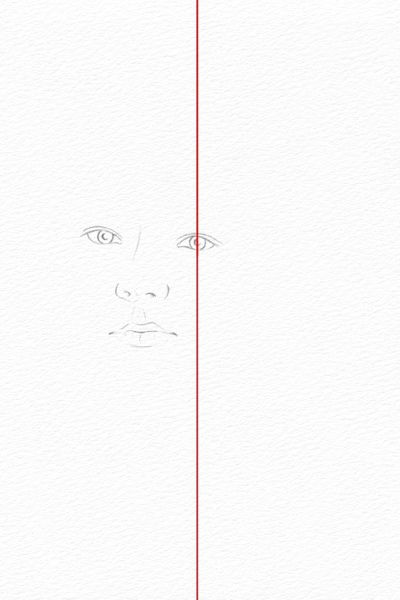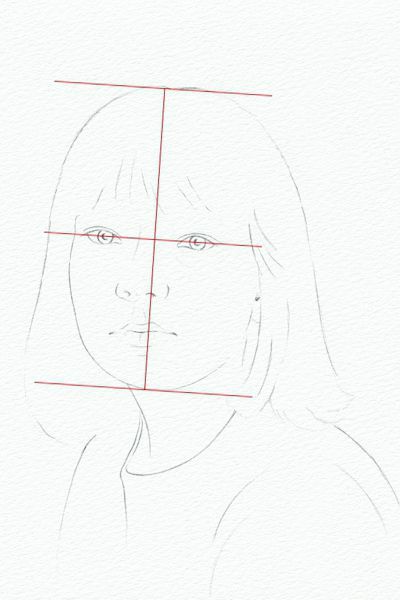Pencil Portrait Drawing
This lesson illustrates and explains the step-by-step drawing techniques used to create a realistic pencil portrait of a young girl.

Pencil Portrait of a Young Girl
Our Pencil Portrait lesson explains and illustrates the step by step drawing techniques involved in creating a portrait of a young girl.
There are three basic stages in the creation of this image:
Step 1: Using line drawing to organise the position, shape and proportion of the features.
Step 2: Using shading to create the tones and form of each feature.
Step 3: Refining the tones to unify all the elements of the portrait.
Step 1: Using line, shape and proportion

Step 1a - Positioning the basic features.
Most artists make the greatest number of changes at the start of a drawing. Therefore it is important to draw lightly at first, as lightly drawn lines are easier to erase.
-
You begin a portrait with the eyes as they are the main focal point. Take care where you choose to position them on the page as this will affect the overall balance of the portrait. In the drawing you will see that right eye is situated on the vertical centre of the page. This is a strong compositional starting point for a three quarter view portrait.
-
The size and position of the other features are directly related to the scale and placement of the eyes.
-
If you get the correct relationship between the eyes, nose and mouth, you will end up with a good likeness.

Step 1b - Establishing the correct proportions.
The next step is to determine the size of the head by establishing the distances between the eyes and the top of the head and the eyes and the chin. Note that these measurements should be similar.
-
The main features are then framed by the outline of the face and hair, while the neck and shoulders form an angular support for the head. The hairline on the right side of the face creates a sweeping curve which meets the neckline of the T-shirt. This movement builds a strong visual link between the head and shoulders.
-
At this stage, the drawing is no more than a set of carefully measured features that establish the final proportions of the head.

Step 1c - Building up the details in line.
The final stage of the line drawing in this portrait is to sketch some of the detail in the hair and the folds on the T-shirt.
-
The lines of detail in the hair should follow the direction and shape of the locks as they split into different strands. They should be drawn quickly and forcefully to give a natural rhythm and vitality to the shape of the hair.
-
The folds in the T-shirt help to emphasise the form and angle of the shoulders. They should be gentle and uncomplicated curves that do not distract your attention from the rest of the portrait.
Step 2: Shading techniques

Step 2a - Shading the tones of the eyes.
You should begin your shading of the portrait with the eyes. The tones used around the eyes should:
-
Help the eyes sit solidly in their sockets by creating a shadow beneath each eyelid where it rests on the eyeball.
-
Give the eyes a sparkling look by placing the brightest highlight against the dark pupil.
-
Create the translucent effect of the iris by capturing its changing tone.
-
Create the curved planes of the eyelids and sockets with softly graduated tone.

Step 2b - Shading the tones of the nose.
The difficulty with drawing the nose from the front is that there are so few outlines to help you define its shape. You have to rely on tone to mould its three dimensional form.
-
Begin by drawing any outlines you can see, namely the edges of the nostrils, the philtrum (the triangular dimple below your nose) and the creases that slope away from the sides of the nose.
-
Next, slowly shade in the main areas of tone as cast by the light.
-
Finally, with careful observation, you can fine-tune the intensity of dark and light tone to create a more realistic looking nose.

Step 2c - Shading the tones of the mouth.
There is a symmetrical arrangement of muscles in the lips and around the mouth which move to form different expressions.
-
By using tone to highlight these muscles, you can add greater realism to the shape of the lips and convey a specific expression in the portrait. The distinctive cracks on the surface of the lips will help to suggest their texture.
-
As a general rule, the upper lip is smaller and darker in tone as it is shaded from the light. The lower lip tends to be fuller and brighter in tone as it catches the light.

Step 2d - Shading the tones of the neck.
The darker tone of the neck forms a strong contrast with the light edge of the chin and jaw. This has the visual effect of lifting and focusing attention on the head.
-
The thin line of reflected light on the left side of the neck highlights a tendon which both physically and visually strengthens the balance of the head.
-
The horizontal bands of tone which create the soft ripples of flesh on the neck help to emphasise its roundness and solidity.

Step 2e - Shading the tones of the hair.
The tone of the hair is created by hatched lines as opposed to the soft graduated tone of the face. These lines should be drawn fast and forcefully and must follow the natural flow of the hair.
-
Build up the tone of the hair in sections according to its natural layers. Use a heavier concentration of lines to shade the darker edges, especially where layers overlap.
-
Ease off gradually to capture the lighter areas, leaving the pure white of the paper to highlight the natural sheen of the hair.

Step 2f - Shading the tones of the t-shirt.
The tone of the T-shirt should add to the solidity of the figure and form a substantial base for the head.
-
Softly graduated shading is used to convey the volume of the figure, while the more detailed folds act as contours to define its surface.
-
The graduated shading technique naturally lends itself to reproducing the soft texture of the T-shirt's fabric.
Step 3: Balancing the Tones

Step 3 - Balancing the tones to create a unified image.
As this drawing was built up by concentrating on each feature individually, some darker areas of tone are now added to balance and unify all the separate elements.
-
At this stage of a drawing, some of the detail is often sacrificed in favour of the overall unity of the image.
-
Finally, a dark background was introduced to balance the tonal composition of the portrait: the right side of the image now appears light against a dark background in counterpoint with the left which is dark against light.







